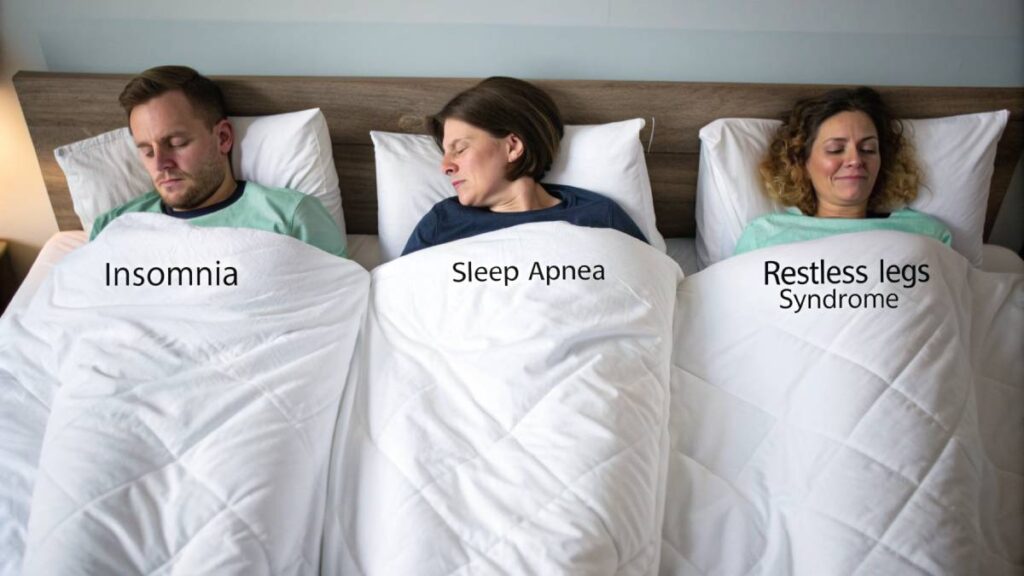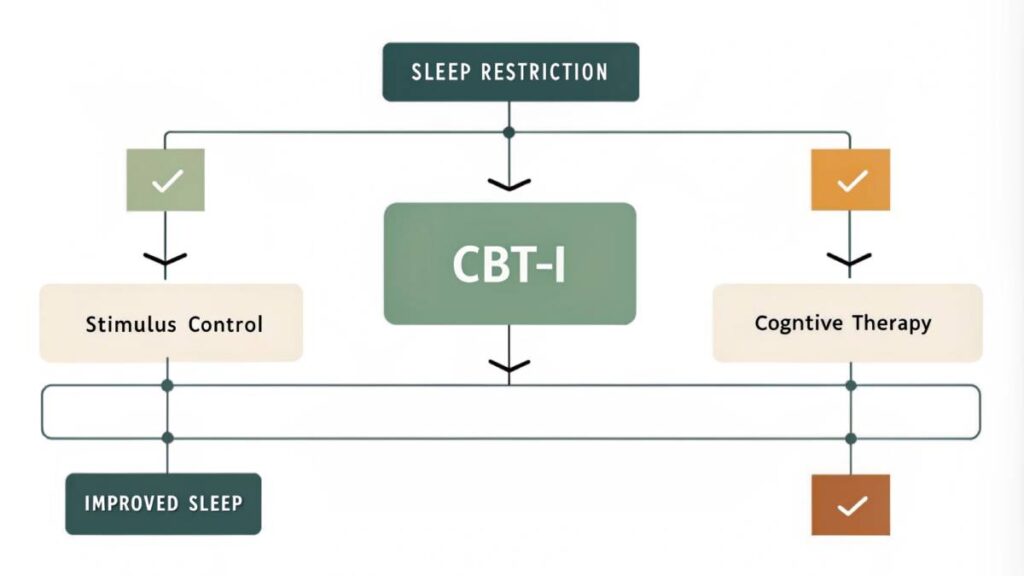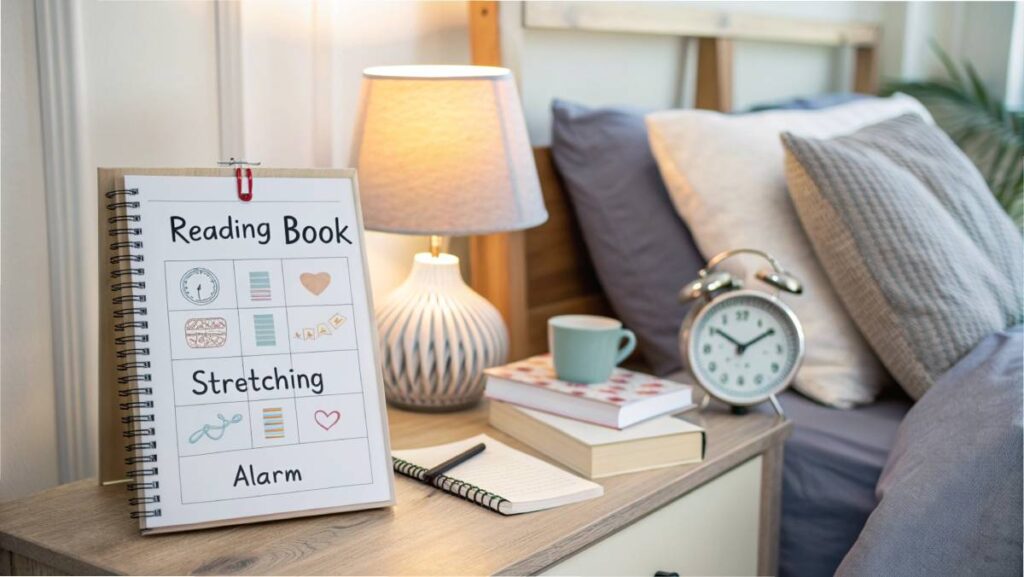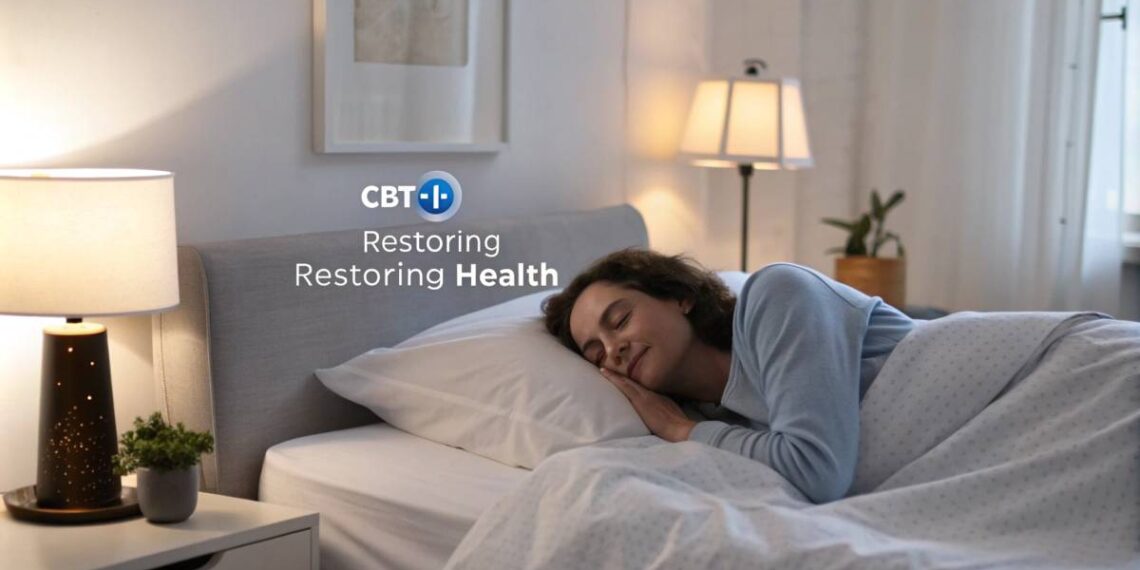Struggling to find quality sleep night after night? You’re not alone. Millions grapple with sleepless nights, impacting their health, mood, and daily performance. But here’s the good news: Cognitive Behavioral Therapy for Insomnia (CBT-I) is a game-changing solution proven to transform restless nights into rejuvenating slumber. Say goodbye to counting sheep and hello to a refreshed, energized you.
Key Takeaways
- Quality Sleep Matters: Sleep is essential for physical, mental, and emotional health, requiring 7-9 hours for optimal function.
- Common Sleep Disorders: Insomnia, sleep apnea, restless legs syndrome, and circadian rhythm disorders disrupt sleep and overall health.
- CBT-I Unpacked: CBT-I addresses insomnia by reshaping thoughts and behaviors for sustainable, healthy sleep patterns.
- CBT-I Techniques: Methods like sleep restriction, stimulus control, and cognitive restructuring improve sleep quality and reduce insomnia.
- Tailored Solutions: CBT-I works for diverse groups, including adults, parents, shift workers, and seniors.
The Importance of Quality Sleep
Understanding the Impact of Sleep on Health
Getting quality shut-eye isn’t just about feeling rested—it’s the backbone of solid health all around. It influences your body, mind, emotions, and how long you might stick around this planet. Dodging those z’s? Not a great plan, it can stir up a storm of health troubles. So, catching some proper snooze time should top the to-do list.
Most grown-ups need between 7 to 9 hours of pillow time every night to really be at their best. When you mix solid sleep with a good-for-you lifestyle, everything clicks much better. You’re sharper, in a better mood, and your body’s defenses stand strong.
| Health Impact | Effect of Sleep Deprivation |
|---|---|
| Mental Performance | Trouble focusing and deciding |
| Emotional Well-being | Crankiness and worry spikes |
| Physical Health | Higher chances of long-term health issues |
| Immune Function | Easier for germs to sneak in |
Getting how sleep ties into health helps folks say yes to things that make for better nights. Check out more on what you can do by hopping over to our piece on sleep hygiene.

Common Sleep Disorders and Issues
Loads of folks wrestle with sleep troubles that can mess with their nightly slumber. Here are a few big ones:
- Insomnia: Can’t seem to drift off or stay in dreamland, leaving you dragging the next day.
- Sleep Apnea: Breaks in breathing while snoozing, which chops up your rest and cuts oxygen intake.
- Restless Legs Syndrome: Legs feeling jumpy, pushing you to move around.
- Circadian Rhythm Disorders: Your body clock is out of sync, which is common with night shifts and getting older.
Spotting these issues means you can take steps, like trying out Cognitive Behavioral Therapy for Insomnia (CBT-I). Plus, carving out a special bedtime ritual could make all the difference in chasing these problems away and catching quality slumber.
| Loud snoring, and gasping while sleeping | Symptoms |
|---|---|
| Insomnia | Hard to fall/stay asleep, sleepy days |
| Sleep Apnea | Loud snoring, gasping while sleeping |
| Restless Legs Syndrome | Jumpy legs, urge to keep moving |
| Circadian Rhythm Disorders | Wacky sleep schedules, feeling wiped |
Tackling sleep headaches right means better health and a happier life. Getting a grip on these is a big win in nailing down healthy sleep habits.

Introduction to CBT-I
What is CBT-I?
Cognitive Behavioral Therapy for Insomnia, or CBT-I for those who love a good abbreviation, is here to tackle sleepless nights head-on. Instead of just glossing over the symptoms, this program digs a bit deeper to untangle the thoughts and habits that keep you tossing and turning. Think of it as a sleep makeover; blending brainy strategies to shake up any pesky sleep-squashing thoughts with practical habits to transform your slumber routine.
CBT-I is like your reliable old friend when it comes to dealing with insomnia. Experts swear by it, and it’s all backed up by stacks of studies. When sleep goes wonky, this therapy rolls up its sleeves, addressing both the thinking and doing parts of your sleep challenges.
“CBT-I is the gold standard for treating insomnia, offering long-term benefits without the side effects of medications.” — Dr. Matthew Walker, Neuroscientist and Sleep Expert.
How CBT-I Helps Improve Sleep
CBT-I has a few tricks up its sleeve to bring on sweet dreams. Check out these power moves:
| Technique | Description |
|---|---|
| Cognitive Restructuring | Swaps out negative sleep thoughts for a kinder, sleep-friendly mindset. |
| Sleep Restriction | Gets tough on bedtime, only allowing time in bed that boosts sleepiness. |
| Stimulus Control | Trains your brain to think bed equals sleep, not TV-watch-a-thons. |
Using these smart tweaks, folks can start logging more restful hours and give insomnia the boot. Studies show this therapy doesn’t just tuck you in for longer and better sleep but also kicks anxiety and depression’s effects on sleep to the curb.

For those dreaming of prime sleep, checking out things like bedtime rituals and a consistent sleep schedule can go hand-in-hand with CBT-I’s magic. These can help lock in the gains from CBT-I and boost your nighttime routine to get you sleeping like a log.
Components of CBT-I
Cognitive Behavioral Therapy for Insomnia (CBT-I) packs a punch with its kickass strategies aimed at tackling sleep problems. Each piece of the puzzle is crafted to jazz up your snooze habits and get your nightly routine on the right track.
Sleep Restriction
So, sleep restriction might sound a little odd, but hang on for a second. It’s all about cutting down the time you spend chilling in bed awake to match the actual snooze time you’re getting. This move amps up your body’s natural sleep mojo, making it a breeze to drift off to dreamland and stick around for the full show.
| Total Sleep Time | Suggested Time in Bed | Sleep Restriction Duration |
|---|---|---|
| 5 hours | 6 hours | 1 hour |
| 6 hours | 7 hours | 1 hour |
| 7 hours | 8 hours | 1 hour |
| 8 hours | 8 hours | No change |
Little by little, you’ll stretch out your bedtime as your sleep game gets stronger, which helps you cozy up to sleep like an old friend. Compliment this with other hacks like sticking to a consistent sleep schedule.
Stimulus Control
Stimulus control is the matchmaker getting your bed and sleep to fall head over heels for each other. It’s about ditching all the junk standing in the way of restful sleep while keeping things simple:
- Hit the sack for sleep and intimacy, nothing else.
- Crawl into bed only when you’re practically sleepwalking.
- If you’re tossing and turning for 20 minutes, find something else to do until you’re yawning again.
- Rise and shine at the same time each day—yes, even on lazy Sundays.
The cherry on top? Sip on a calming pre-sleep routine to wrap up the day on a chill note, paving the way to dreamland.
Cognitive Therapy
Cognitive therapy kicks insomnia where it hurts by tackling those pesky thoughts and myths about sleep:
- Bust those silly sleep myths like “I’m doomed if I don’t clock in eight hours tonight.”
- Master handy tricks to keep sleep freak-outs at bay.
- Swap doom-and-gloom thoughts for more down-to-earth, uplifting ones.
Mindfulness or the good ol’ 4-7-8 breathing technique are your zen sidekicks to calm the storm in your head. Bonus? Sleep journaling to lay out everything in black and white, giving you the lowdown on your sleep trends.
CBT-I hands you a toolkit for kicking sleep troubles to the curb. By weaving these techniques into your life, you get the reins back on your sleep cycle, steering towards better health and well-being. If you’re itching for more golden nuggets on bedtime routines and healthy snooze habits, check out the scoop on bedtime rituals.

Developing Healthy Sleep Habits
Getting your sleep game on point is way more than just closing your eyes at night. We’re talking about crafting habits that lay the groundwork for dreamy sleep nights. These are especially helpful in Cognitive Behavioral Therapy for Insomnia (CBT-I), which uses mental tricks to turn snooze troubles around.
“Sleep is the foundation for health and vitality, impacting every aspect of life.” — Arianna Huffington, Author of The Sleep Revolution.
Establishing a Bedtime Routine
Think of your bedtime rituals as a soothing lullaby for your body. It’s like telling your body, “Hey, time to hit the sack!” Whether it’s diving into a novel, doing a gentle stretch, or practicing deep breathing, these activities send the message that sleep’s on the horizon. Here’s a handy guide for winding down:
| Activity | Time Suggested |
|---|---|
| Get lost in a book | 20-30 minutes |
| Loosen up with some stretches | 10-15 minutes |
| Try the 4-7-8 breathing thing | 5 minutes |
| Jot down your thoughts | 10-15 minutes |
Once you get into your groove, you can read more about a pre-sleep routine and customized bedtime rituals that fit you like a glove.
Creating a Sleep-Inducing Environment
Where you sleep can make or break your snooze. A killer sleep setup means saying bye-bye to noises, keeping it dark, and dialing your room just right. Here’s how to create your sleep haven:
| Condition Element | Ideal Groove |
|---|---|
| Room Feel | Cool and cozy at 60-67°F (15-19°C) |
| Sound | Tranquil (you might love white noise machines for sleep) |
| Light | Pitch black (think blackout curtains or a comfy sleep mask) |
| Comfort | Get a bed and pillows your body says “ahhh” to |
A hint of lavender wafting around can just make that sleep space perfect. Try ditching screens before sleep with a digital detox for sleep to keep gadgets from interrupting your rest.
Importance of Consistency
Sticking to a regular sleep routine is your ticket to predictable zzz’s and easier mornings. Getting into a pattern helps set your internal alarm so waking up feels like second nature. Here’s how to keep it steady:
| Tip | What to Do |
|---|---|
| Set Your Sleep Clock | Go to bed and rise with the sun at the same hours, weekend or not (weekend sleep patterns). |
| Keep Napping Short | If you snooze midday, keep it brief (20-30 minutes) so it doesn’t crash your night sleep (power naps). |
| Morning Sunshine | Catch early rays to reset your circadian rhythm. |
Jump into more healthy sleep habits and check how a consistent sleep schedule can up your sleep quality game.
Implementing CBT-I Techniques
When it comes to making sleep less of a nightmare, CBT-I (that’s Cognitive Behavioral Therapy for Insomnia for the newbies) is like the trusty toolbox. Let’s riffle through some straightforward methods that make restless nights a thing of the past and put us on the path to dreamy slumber.
Keeping a Sleep Diary
Think of a sleep diary as your best friend that spills your secrets. Jotting down your z’s in a notebook gives a peek into your sleep habits and tips off what might be disrupting your snooze fest.
Here’s the kind of dirt your diary should dish:
| Date | Bedtime | Wake Time | Total Sleep Time | Sleep Quality (1-10) | Notable Events (Caffeine, Stress) |
|---|---|---|---|---|---|
| YYYY-MM-DD | 10:30 PM | 6:30 AM | 8 hours | 7 | One coffee at 3 PM |
| YYYY-MM-DD | 11:00 PM | 7:00 AM | 8 hours | 6 | Work stress |
Keep jotting in your diary like it’s your gossip journal. Spotting patterns, like drinking coffee too late, can help you tweak your habits. Want more hints? Peek at our piece on sleep journaling.
Gradual Changes for Better Sleep
Rome wasn’t built in a day, and your perfect sleep won’t be either! Slow and steady wins this sleep race. Tweaking things little by little is less jarring—and you’ll stick to it longer.
Consider these mini-makeovers:
- Shift your sleep time by 15-30 minutes earlier or later.
- Spend less time lounging in bed awake.
- Cut down on electronic screen time pre-sleep, adding more screen-free moments gradually.
Changing in manageable bits will ensure a smoother shift to healthier habits. For hacks on sticking to this, pop over to our consistent sleep schedule guide.
| Change | Suggested Change | Duration |
|---|---|---|
| Bedtime | 15-30 minutes | Weekly |
| Screen Time Cutback | 10-15 minutes | Every Night |
| Awake in Bed | 5-10 minutes | Weekly |
Addressing Underlying Factors
Got gremlins causing your insomnia? Time to banish those culprits like stress and unhealthy routines. From anxiety to an all-day Netflix marathon, fixing them can guide you back to blissful sleep. Here’s how:
- Learn relaxation moves like the cool 4-7-8 breathing trick to chill out.
- Rework nighttime antics by dumping caffeine and creating a calming pre-sleep routine.
- Get moving! Regular exercise is a sleep booster. Learn more with our chat on exercise and sleep quality.
Addressing these issues and bearing down on proven strategies beef up your sleep plan. Consistency’s key—stick with it for lasting ease into sleep.
CBT-I for Different Groups
Cognitive Behavioral Therapy for Insomnia (CBT-I) is like a magic trick for snooze troubles, helping folks get better shut-eye. It’s a flexible approach, handy for adults, parents wrestling with bedtime chaos, night-shift workers, and our golden-agers.

CBT-I for Adults
Adults often find themselves tossing and turning, thanks to stress, busy lives, or pesky health issues. CBT-I tackles the loop of thoughts and habits feeding insomnia. Grown-ups benefit big-time from setting a regular sleep routine and learning a few chill-out moves.
| Strategy | What’s It For? | What’s the Deal? |
|---|---|---|
| Sleep Restriction | Boosts sleep quality by limiting bedtime | Stick to set sleep and wake hours |
| Stimulus Control | Connects bed with dozing off | Snooze only in bed, not Netflix |
| Cognitive Therapy | Zaps sleepless worries | Tweak those thoughts and break worries |
CBT-I for Parents and Children
Kid wrangling at bedtime can be like herding cats, right parents? CBT-I lends a hand in setting up bedtime rituals that might just tame the chaos. Folks learn to chill the kids before bed and jazz up the sleep vibe at home.
| Key Aspect | What’s the Scoop? | Helps Sleep How? |
|---|---|---|
| Establishing Routines | Set clear bedtime vibes | Guides kids to know ‘sleep time’ |
| Bedroom Environment | Make the room a snooze haven | Less noise means less sleep fuss |
| Consistent Sleep Schedule | Keeps everyone on a sleep track | Helps natural bedtime signals |
Check out more snooze tips with our piece on bedtime rituals.
CBT-I for Shift Workers and Seniors
Folks working off-hours, like night owls, might find catching Z’s a struggle. CBT-I comes through with strategies like a circadian rhythm reset for those odd hours. Our elders, meanwhile, sometimes deal with sleep hiccups linked to getting older. CBT-I zeroes in on habit-forming and relaxation.
| Group | What Gives With Sleep? | How CBT-I Helps |
|---|---|---|
| Shift Workers | Crazy hours, zombie fatigue | Focus on sleep environment and light cues |
| Seniors | Age woes, changing sleep patterns | Cognitive strategies and routine rules |
Our elder crew can tackle sleep debt by sticking to consistent sleep schedules.
CBT-I shows its chops across different lives, tweaking its methods to tackle sleep woes. With strategies custom-fit for each person, CBT-I turns into a sleep superhero for better bedtime routines and habits. For extra tips, peek at our articles on sleep journaling or digital detox for sleep.
Conclusion
Quality sleep isn’t a luxury—it’s a necessity for a healthy and happy life. CBT-I offers a proven, practical path to overcoming insomnia and establishing sustainable sleep habits. By understanding the interplay between thoughts, behaviors, and bedtime routines, you can regain control over your nights and wake up ready to conquer your days. Start implementing CBT-I techniques today and reclaim your sleep—your body and mind will thank you.
FAQs
What is CBT-I?
CBT-I, or Cognitive Behavioral Therapy for Insomnia, is a structured, evidence-based approach to treating insomnia by changing thoughts and behaviors that hinder sleep.
How does CBT-I improve sleep?
CBT-I employs techniques like cognitive restructuring, sleep restriction, and stimulus control to promote healthier sleep habits and patterns.
Who can benefit from CBT-I?
CBT-I is effective for adults, parents managing children’s sleep, night-shift workers, and seniors with age-related sleep issues.
How long does CBT-I take to show results?
Typically, significant improvements can be seen in 4-8 weeks of consistent CBT-I practice.
Are there any side effects of CBT-I?
CBT-I is non-invasive and safe, with no side effects, making it a preferred choice over medication for insomnia treatment.
Resources
- National Sleep Foundation: Comprehensive sleep research and tips.
- American Academy of Sleep Medicine: Guidelines and resources on sleep health.
- CDC Sleep and Sleep Disorders: Public health information on sleep disorders.








